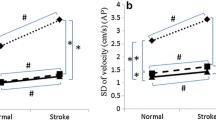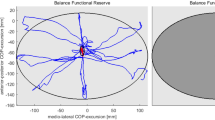Abstract
Technological advances have led to the development of new measurement techniques that have improved the evaluation, diagnosis, and treatment of patients with vertigo, dizziness and balance disorders. The objective of this study was to propose population normality patterns, adjusted for age, for summary option (balance control summary, BCS) of Sway Star system. Prospective study involving 70 healthy individuals (average age 44.9 years) evenly distributed in seven age groups and who underwent a postural study with the Sway Star system. The normality patterns for the BCS are presented in Tables 2, 3 and 4. No influence of the gender variable was found. Age had an influence in the more sensorially complex stance tests, and the sensory analysis (visual and vestibular contributions). No influence of age in gait tests or in balance control indexes was found. The BCS option is the most feasible way of systematically using the Sway Star, because it provides complete information of the patient’s postural capacity in sensorially complex settings. Establishing normality patterns is the initial and essential step to validate the usefulness of Sway Star in the study of patients with balance disorder. Gait test results were not influenced by age because of their greater capacity to reproduce physiological situations; these could be the tests of choice for detecting elderly patients with a tendency to fall.
Similar content being viewed by others
References
Baydal-Bertomeu JM, Barberà i Guillem R, Soler-Gracia C, Peydro de Moya MF, Prat JM, Barona de Guzman R (2004) Determinación de los patrones de comportamiento postural en población sana española. Acta Otorrinolaringol Esp 55:260–269
Mathesona AJ, Darlingtona CL, Smith PF (1999) Further evidence for age-related deficits in human postural function. J Vestib Res 9:261–264
Hegeman J, Yu Shapkova E, Honeggera F, Allum JHJ (2007) Effect of age and height on trunk sway during stance and gait. J Vest Res 17:75–87
Gill J, Allum JH, Carpenter MG, Held-Ziolkowska M, Adkin A, Honegger F et al (2001) Trunk sway measures of postural stability during clinical balance test: effects of age. J Gerontol A Biol Sci Med Sci 56:438–447
Basta D, Rossi-Izquierdo M, Soto-Varela A, Greters ME, Bittar RS, Steinhagen-Thiessen E et al (2011) Efficacy of a vibrotactile neurofeedback training in stance and gait conditions for the treatment of balance deficits: a double-blind, placebo-controlled multicenter study. Otol Neurotol 32(9):1492–1499
Thapa PB, Gideon P, Brockman KG, Fought RL, Ray WA (1996) Clinical and biomechanical measures of balance as fall predictors in ambulatory nursing home residents. J Gerontol A Biol Sci Med Sci 51:239–246
Goebel JA, Sinks BC, Parker BE Jr, Richardson NT, Olowin AB, Cholewiak RW (2009) Effectiveness of head-mounted vibrotactile stimulation in subjects with bilateral vestibular loss: a phase 1 clinical trial. Otol Neurotol 30(2):210–216
Allum JHJ, Zamani T, Adkin A, Ernst A (2002) Differences between trunk sway characteristics on a support surface on the Equitest® and sway-references support surface. Gait Posture 16:264–270
Carpenter MG, Allum JHJ, Honegger F (2001) Vestibular influences on human postural control in combinations of pitch and roll planes reveal differences in spatiotemporal processing. Exp Brain Res 140:95–111
Van de Warrenburg BPC, Bakker M, Kremer MPH, Bloem BR, Allum JHJ (2005) Trunk sway in patients with spinocerebellar ataxia. Mov Disord 20(8):1006–1013
Horlings CG, Küng UM, Bloem BR, Honegger F, Van Alfen N, Van Engelen BG et al (2008) Identifying deficits in balance control following vestibular or proprioceptive loss using posturographic analysis of stance tasks. Clin Neurophysiol 119:2338–2346
Faraldo-García A, Santos-Pérez S, Crujeiras R, Labella-Caballero T, Soto-Varela A (2012) Comparative study of computerized dynamic posturography and the SwayStar system in healthy subjects. Acta Otolaryngol 132(3):271–276
Rey-Martínez JA, Boleas-Aguirre MS, Pérez N (2005) Análisis postural de la prueba “Timed-up-and-go” en pacientes con vértigo. Acta Otorrinolaringol Esp 56:107–111
Grimbergen YA, Knol MJ, Bloem BR, Kremer BP, Roos RA, Munneke M (2008) Falls and gait disturbances in Huntington’s disease. Mov Disord 23:970–976
Faraldo-García A, Santos-Pérez S, Labella-Caballero T, Crujeiras R, Soto-Varela A (2012) Influence of age and gender in the sensory analysis of balance control. Eur Arch Otorhinolaryngol 269(2):673–677
Faraldo-García A, Santos-Pérez S, Labella-Caballero T, Soto-Varela A (2011) Influence of gender on the sensory organisation test and the limits of stability in healthy subjects. Acta Otorrinolaringol Esp 62(5):333–338
De Hoon EW, Allum JH, Carpenter MG, Salis C, Bloem BR, Conzelmann M et al (2003) Quantitative assessment of the stops walking while talking test in the elderly. Arch Phys Med Rehabil 84:838–842
Author information
Authors and Affiliations
Corresponding author
Rights and permissions
About this article
Cite this article
Faraldo-García, A., Santos-Pérez, S., Labella-Caballero, T. et al. Age-adjusted normality patterns for posturography by Sway Star system. Eur Arch Otorhinolaryngol 270, 3169–3175 (2013). https://doi.org/10.1007/s00405-013-2508-y
Received:
Accepted:
Published:
Issue Date:
DOI: https://doi.org/10.1007/s00405-013-2508-y




